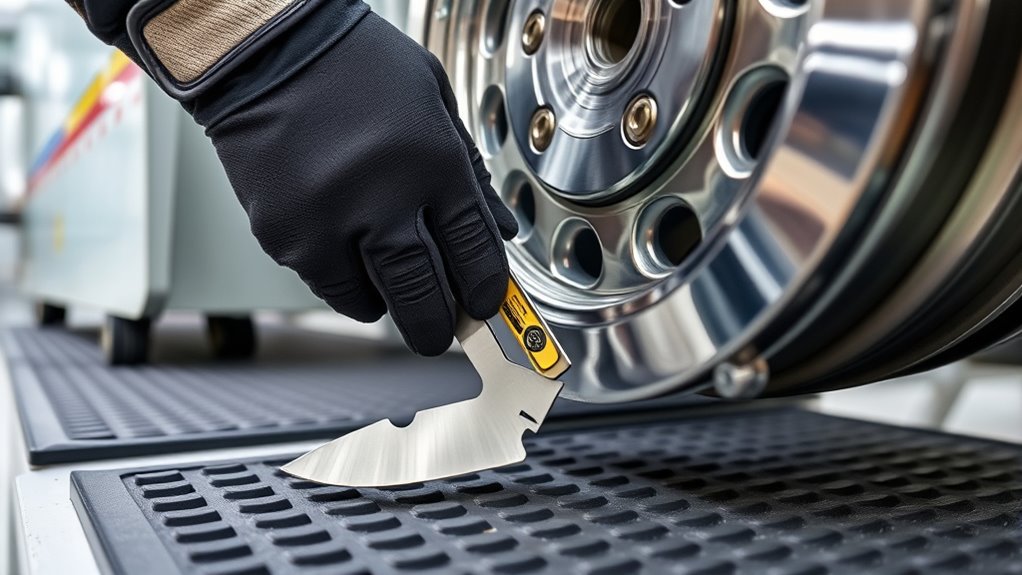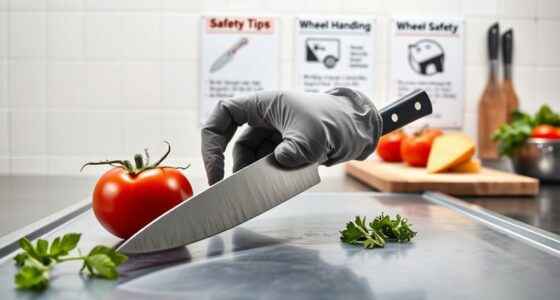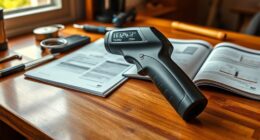To stay safe when working with knives and wheels, always handle tools with proper technique, wearing protective gear and maintaining a steady grip. Regularly inspect and sharpen blades, check wheels for damage, and keep everything clean. Create an organized workspace and follow safety protocols to prevent accidents. Focus on your task, avoid distractions, and use controlled movements. Keep yourself safe by mastering these basics—you’ll find even more helpful tips if you continue exploring.
Key Takeaways
- Always wear protective gear such as cut-resistant gloves and safety glasses when handling knives and wheels.
- Regularly inspect and maintain blades and wheels, sharpening or replacing as needed to ensure safety and efficiency.
- Use proper handling techniques, including ergonomic grips and steady movements, to prevent slips and injuries.
- Keep your workspace clean and organized, storing tools securely and removing clutter to minimize hazards.
- Follow established safety protocols and emergency procedures to respond effectively to incidents and prevent accidents.
Proper Handling and Technique

To guarantee safety when using knives and wheels, you must handle them with proper technique. Always wear protective gear, like cut-resistant gloves and safety glasses, to shield yourself from potential injuries. When gripping tools, use an ergonomic grip to maintain control and reduce hand fatigue, which helps prevent slips or mishaps. Keep your hands dry and steady, and position your body correctly—stand with a firm stance, close to your work, to enhance stability. Focus on your task, avoiding distractions. Use smooth, controlled movements, and never rush. Proper handling minimizes risks, ensuring you work efficiently and safely. Remember, consistent attention to your grip, protective gear, and technique is essential to prevent accidents when working with knives and wheels. Additionally, understanding safety protocols can significantly reduce the likelihood of injuries during these activities.
Maintenance and Inspection Practices

Regular maintenance and thorough inspections are essential for ensuring knives and wheels remain safe and effective during use. Start by regularly checking blades for dullness or damage, and perform blade sharpening as needed to maintain a clean, precise cut. Inspect wheels for cracks, chips, or wear that could compromise safety. Always wear protective gear, such as gloves and eye protection, during inspections and maintenance to prevent injuries. Keep blades and wheels clean from debris and buildup, which can affect performance. Record inspection dates and maintenance tasks to track wear patterns and schedule timely replacements. Additionally, understanding the contrast ratio of your projector can help optimize image quality during setup. By proactively maintaining and inspecting your tools, you reduce the risk of accidents, improve efficiency, and extend the lifespan of your equipment.
Safe Operating Environment

Creating a safe operating environment is essential for preventing accidents and ensuring efficient use of knives and wheels. You should implement proper storage procedures to keep tools secure and accessible, reducing the risk of injury. Maintain a clean workspace free of clutter to minimize hazards. Additionally, familiarize yourself with emergency response plans, so you’re prepared to act quickly if an accident occurs.
Key steps include:
- Organize tools with designated storage to prevent accidental contact.
- Regularly inspect equipment to identify potential safety issues.
- Train yourself and others on emergency procedures to respond effectively during incidents.
Frequently Asked Questions
What Are the Most Common Accidents Involving Knives and Wheels?
You’re most likely to experience blade injuries or wheel accidents when handling knives or operating wheels. Common accidents include cuts from improper knife use or handling, and slips causing wheel collisions or falls. To prevent these, always stay focused, use proper techniques, and wear safety gear. Paying attention to your surroundings helps avoid unexpected blade injuries and wheel accidents, keeping you safer while working with these tools.
How Do I Choose the Right Safety Gear for Operation?
Choosing the right safety gear is like selecting armor for battle—you need the best fit and protection. Start by evaluating your task, then opt for personal protective equipment like cut-resistant gloves, eye protection, and sturdy footwear. Make sure your gear fits properly and is in proper maintenance, free of damage. Prioritize quality and comfort, so you stay protected and focused, reducing the risk of accidents while operating knives and wheels.
Are There Specific Regulations for Knife and Wheel Safety?
Yes, there are specific regulations for knife and wheel safety, and you need to follow industry standards and compliance regulations. These rules are designed to guarantee safe operation and reduce injuries. You should regularly check updates from OSHA or your local safety authorities, and always adhere to manufacturer guidelines. Staying informed and compliant helps protect you and your coworkers, and keeps your workspace safe and efficient.
How Often Should Safety Training Be Refreshed?
They say “practice makes perfect,” and that’s especially true for safety. You should refresh your training at least annually to keep skills sharp, but more frequent updates are even better, especially if procedures change. Regular training reinforces safe habits, making accidents less likely. Remember, the importance of refresher training can’t be overstated—it keeps safety top of mind and ensures everyone handles knives and wheels safely and confidently.
What Emergency Procedures Should I Follow After an Incident?
In an emergency, you should immediately prioritize your safety and follow your workplace’s emergency response plan. Quickly alert others and seek medical help if needed. Report the incident promptly by following your reporting procedures, providing clear details about what happened. Stay calm, assist others if possible, and cooperate with emergency responders. Properly documenting the incident guarantees it’s handled correctly and helps prevent future accidents.
Conclusion
By mastering proper handling and regular maintenance, you guarantee safety isn’t just a goal but a habit. A clean, organized workspace might seem simple, but it’s your first line of defense against accidents. Just like a sharp knife needs careful attention, your skills and environment must stay sharp. When you blend technique with awareness, safety becomes second nature—transforming potential hazards into opportunities for confident, secure operation every time.









